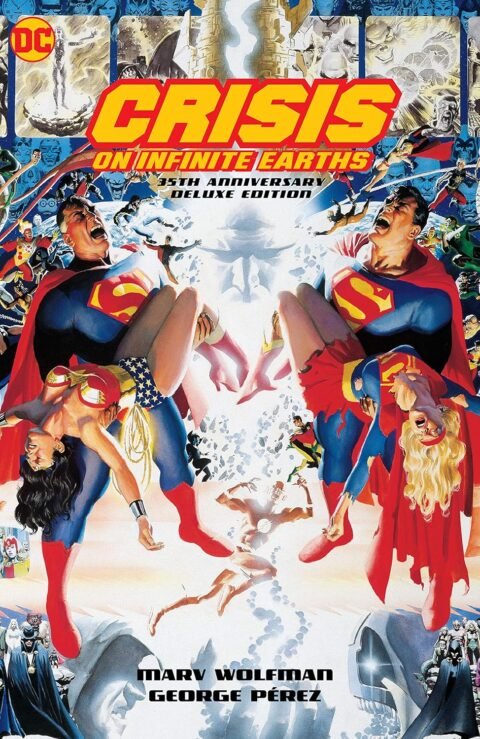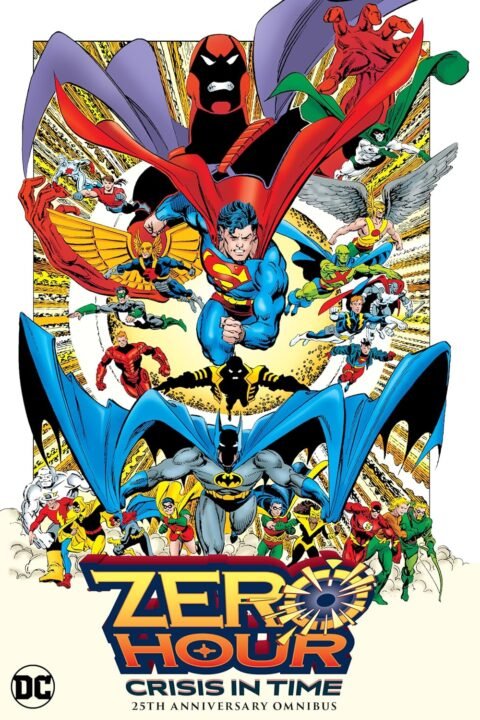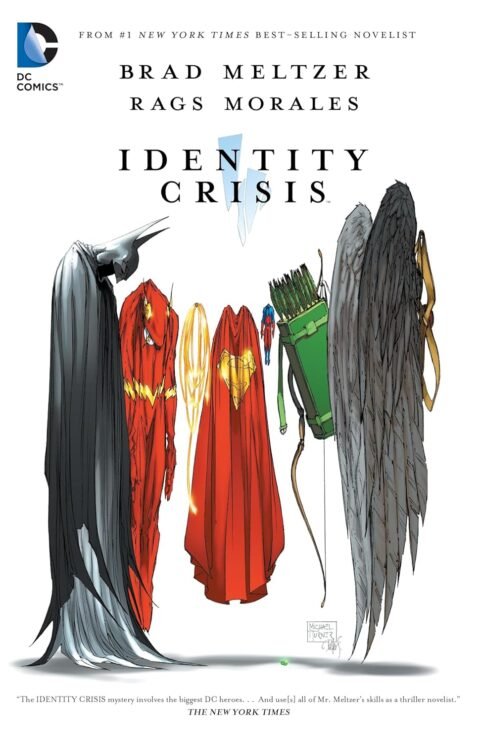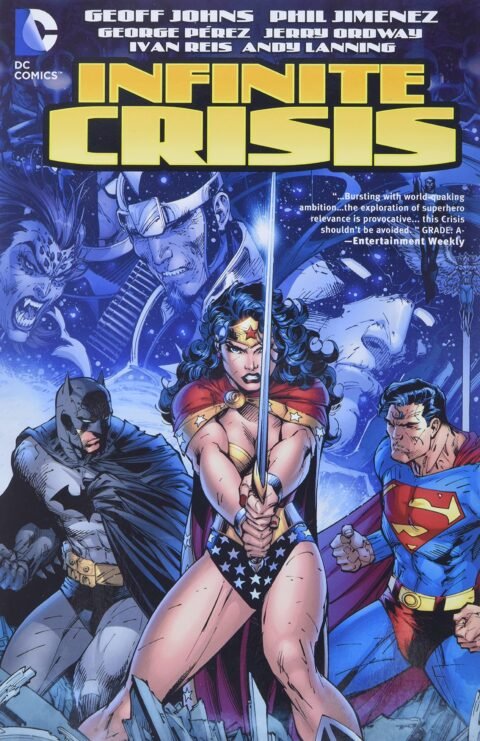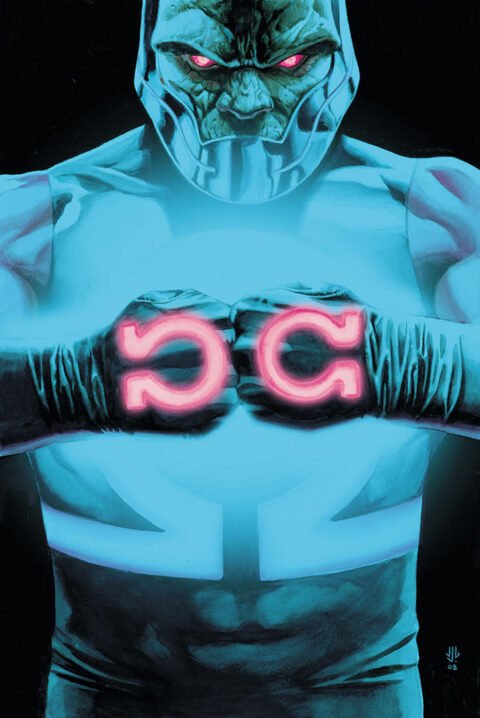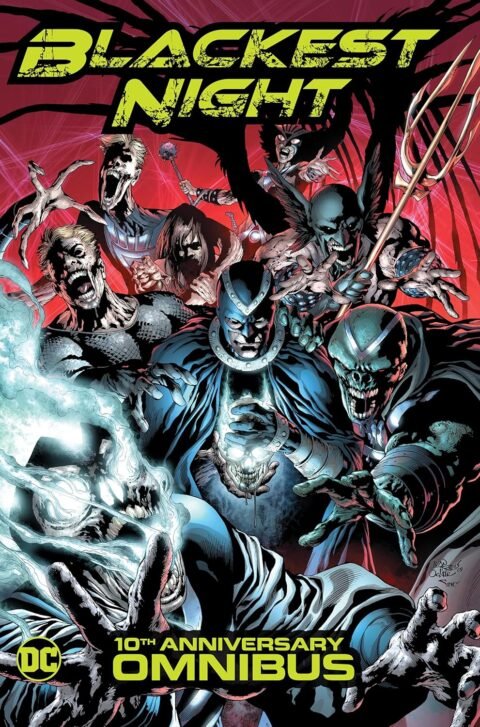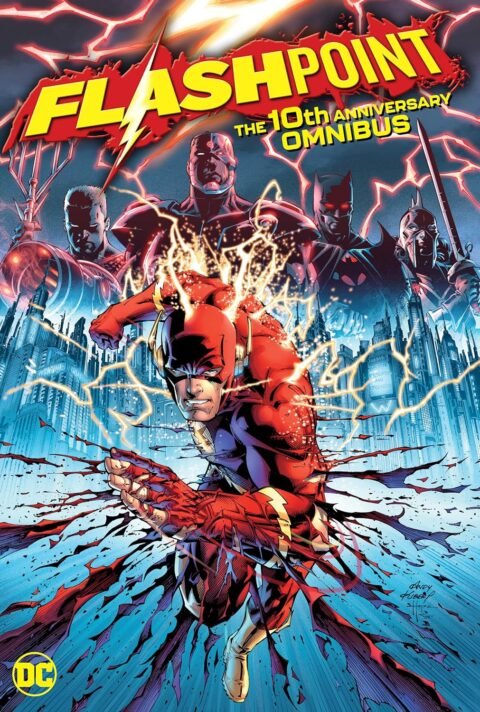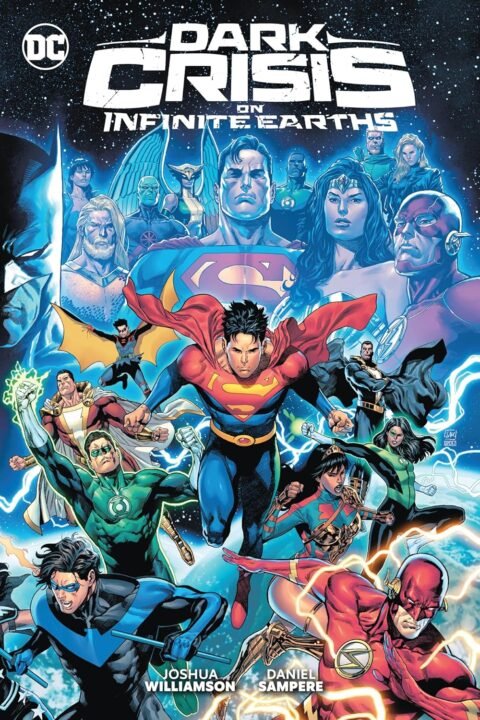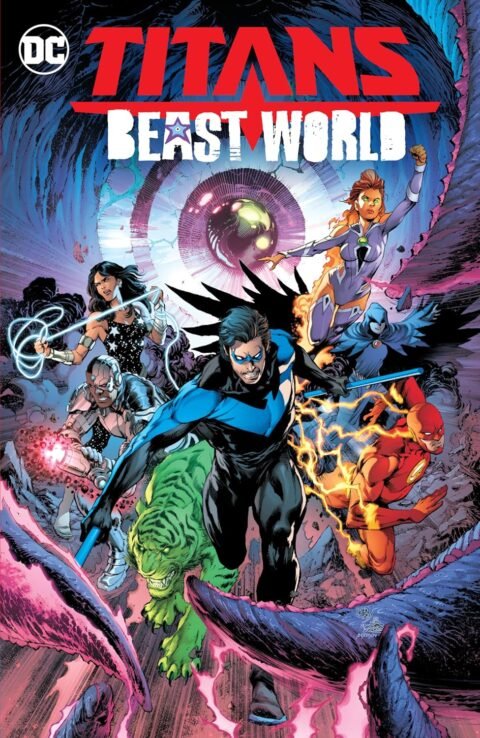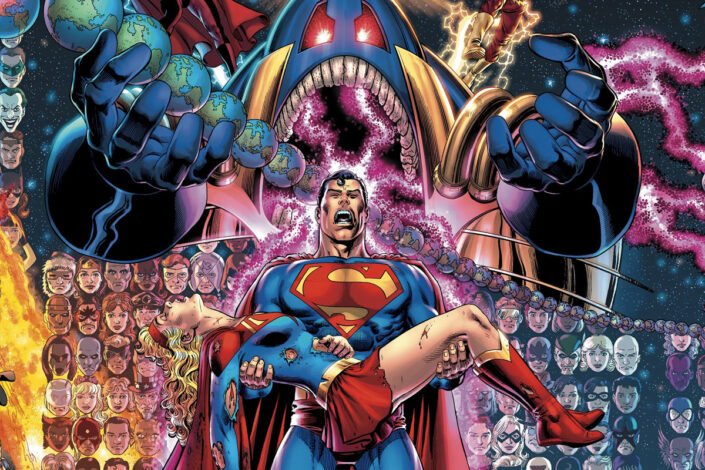
For decades now, every DC Comics reader has been dealing with continuity issues. Some see that as a problem and, in order to fix it, multiple reboots/relaunches were introduced, installing a new status-quos, and launching new “eras.” All that with the use of what are called “Crisis” events.
The original “Crisis” took place in Justice League of America #21, titled “Crisis On Earth-One!” The story introduced the idea of two different realities, explaining how the heroes of the Justice League teamed up with their predecessors from the Justice Society of America. This led to multiple crossovers between Earth-One and Earth-Two.
But what cemented “Crisis” as a synonym for “universe-altering event” was the 1985 Crisis on Infinite Earths, the famous crossover storyline from Marv Wolfman and George Pérez. This 12-issue limited series is now credited with popularizing the idea of a large-scale crossover in comics. At the time, the goal was to create a single and unified DC Universe.
Crisis on Infinite Earths was used to launch what is now called the Modern-Age era. It became–and still is for a lot of readers–a good entry point into the DCU. The event didn’t fix everything and other Crisis events try to do more. The DCU was just destined to become a confusing affair once more.
Nevertheless, reading from Crisis to Crisis is not a simple task as the series are numerous, as well as the crossovers. If you want to explore this rich story, the task is overwhelming. There are a lot of roads to follow, but you may only want the short version–or at least, the essential reading recommendation.
This reading guide is here to offer one possible road to follow. It’s not definitive, feel free to submit more books to read in the comment section (and tell us why they are a must-read!).
From Crisis to Crisis: A DC Comics Reading Order
Crisis on Infinite Earths marks the end of the Bronze Age. Of course, there is a lot to read from the Golden Age to that point, but it’s not the goal of this article to deal with that. It will be the subject of another article. For now, let’s take a look at what introduced the ideas, concepts, and characters leading to the Modern Age.
The Road to Crisis on Infinite Earths
As Crisis on Infinite Earths used every DC Comics’ characters, it would be difficult and pointless to familiarize yourself with the entirety of the DCU just before everything got rebooted. Nevertheless, here are a few issues that introduce key concepts used during the Crisis. It’s not required reading though.
- All-Star Comics #3 (1940) established the fact that all DC Comics characters coexisted in the same world when superheroes who starred in their own series met each other for the first time and founded the Justice Society of America.
- Flash #123 (1961), aka “The Flash of Two Worlds,” is the iconic comic book that gave us the first team-up between Barry Allen and Jay Garrick. By doing so, it introduced the idea of the DC Multiverse–even if it was not called that at the time.
- Justice League of America #21-22, as I said in the introduction, was the first Crisis, the first Justice League/Justice Society team-up–all the team-ups have been collected in the Crisis on Multiple Earths collection (see the JSA Reading Order).
- Green Lantern #40 (1965), “The Secret Origin of the Guardians,” introduced Krona, whose ambitions led to the Crisis. Also, even if they met earlier, this was the first real team-up between Hal Jordan and Alan Scott.
- If you want to read stories from just before the Crisis, DC put out the book DC Through the ’80s – The End of Eras (Collects Action Comics #583, Detective Comics #500, The Flash #296-298, Jonah Hex #54-55, Superman #423, House of Mystery #286, #290, #294-295, #300, #308, #321, Warlord #42, Wonder Woman #311-312, The Brave and the Bold #200, Weird War Tales #93, Time Warp #2 and #3, G.I. Combat #288, Blackhawk #258, DC Comics Presents Annual #1, Super Friends #36, and Sgt. Rock #345, #347, #368, and #387).
Crisis on Infinite Earths (1985)
The end of the DC Universe as we knew it, and the birth of a new one that led us into the Modern Age.
Everything starts with a mysterious being known as the Anti-Monitor as he begins a crusade across time to bring about the end of all existence. As alternate Earths are systematically destroyed, the Monitor quickly assembles a team of superheroes from across time and space to battle his counterpart and stop the destruction. DC’s greatest heroes, including Superman, Batman, Wonder Woman, Green Lantern, and Aquaman, assemble to stop the menace, but as they watch both the Flash and Supergirl die in battle, they begin to wonder if even all of the heroes in the world can stop this destructive force.
The event is a 12-issue miniseries that is completed with lots of tie-ins. Take a look at our Crisis on Infinite Earths reading order to learn more about that.
- Crisis on Infinite Earths
Collects Crisis on Infinite Earths #1-12. - Crisis on Infinite Earths Companion Deluxe Edition Vol. 1
Collects DC Comics Presents #78, All-Star Squadron #50-60, The Fury of Firestorm #41-42 and Green Lantern #194-198. - Crisis on Infinite Earths Companion Deluxe Edition Vol. 2
Collects DC Comics Presents #86, Swamp Thing #44, Losers Special #1, Legends of the DC Universe: Crisis on Infinite Earths #1, Infinity, Inc. #18-25, Infinity, Inc. Annual #1, Justice League of America #244-245, New Teen Titans (Series 2) #13-14 and a story from Detective Comics #558. - Crisis on Infinite Earths Companion Deluxe Edition Vol. 3
Collects Amethyst #13, The Omega Men #31, a story from The Omega Men #33, Blue Devil #17-18, Wonder Woman #327-329, Swamp Thing #46, Legion of Super-Heroes #16 and #18, Superman #413-415, DC Comics Presents #87-88 and #94-95, Justice League of America Annual #3, and pages from Superman and Batman: World’s Funnest #1.
Unlike what you may think, all of DC’s titles were not immediately rebooted. It happened between 1986 and 1989. The first post-Crisis Batman was #401; for Detective Comics, it’s #568. Superman was relaunched with a new #1, but Action Comics continued with #584, though the first post-crisis appearance of Superman was in DC Comics Presents #89.
- Legends
This quite optional event was used to establish the New Earth continuity post-Crisis on Infinite Earths. - History of the DC Universe
Narrated by Harbinger, a central figure in the Crisis storyline, the reader is brought through the new history of the world and its heroes (also collected in DC Through the ’80s: The Experiments, see below).
Want an idea of what DC Comics became after the Crisis, take a look at the next book:
- DC Through the 80’s: The Experiments
Collects Secret Origins #48, Swamp Thing #40, The Sandman #8, Doom Patrol #25, Warlord #48 and #55, Legion of Super-Heroes #298, Nathaniel Dusk #1, Infinity Inc. #14, The New Teen Titans #16, The Best of DC: Blue Ribbon Digest #58, Watchmen #1, Camelot 3000 #1, Batman: The Dark Knight Returns #2, Angel Love #1, and History of the DC Universe #1-2.
In an effort to fix some continuity problems born from the Crisis on Infinite Earths, DC Comics decided to write off the JSA from active continuity.
- Last Days of the Justice Society of America (1986)
Collects Last Days of the Justice Society of America Special #1, plus stories from Secret Origins #7, 9, 11, 13, 15, 16, 18, 20, 24, 25, and 31. - Armageddon 2001 (1991)
Collects Armageddon 2001 #1-2. Introduction of the supervillain Monarch who, during Zero Hour, became known as Extant.
The sequel miniseries Armageddon: Inferno (1991, not collected) was used to bring back the JSA.
And then, Superman died!
- The Death and Return of Superman Omnibus (1992)
Collects Superman: The Man Of Steel #17-26, Superman #73-83, Adventures Of Superman #496-505, Action Comics #683-692, Justice League America #69, Superman: The Legacy Of Superman #1 and Green Lantern #46.- If you want the bare minimum, take a look at “Reign of the Supermen!” and “The Return of Superman.”
- Green Lantern: Kyle Rayner Vol. 1
Collects Green Lantern #48-57, New Titans #116-117, and R.E.B.E.L.S. #1.
Zero Hour: Crisis In Time (1994)
This Crisis is not one of the more famous, but it also changed the DC Universe as it did end in a reboot for some part of the continuity.
All of reality comes under attack when a mysterious force of entropy begins slowly erasing time itself—making its way from both the past and future toward the present! As history itself unravels around them, the heroes of the world—including Superman, Batman, Wonder Woman, The Flash, The Justice Society, and the Titans—scramble to fix the broken timestream. But even if they stop the true source of the chaos, the world they save will never be the same!
Take a look at our Zero Hour: Crisis In Time Reading Order for more detail.
- Zero Hour: Crisis in Time 25th Anniversary Omnibus
Collects Action Comics #703, Adventures of Superman #516, Anima #7, Batman #511, Batman: Shadow of the Bat #31, Catwoman #14, Damage #6, Darkstars #24, Detective Comics #678, The Flash #0 and #94, Green Arrow #90, Green Lantern #0 and #55, Guy Gardner: Warrior #24, Hawkman #13, Justice League America #92, Justice League International #68, Justice League Task Force #16, L.E.G.I.O.N. ’94 #70, Legionnaires #18, Legion of Super-Heroes #61, Outsiders #11, Robin #10, Steel #8, Superboy #8, Superman #93, Superman: Man of Steel #37, Team Titans #24, Valor #23, Zero Hour #4-0, and stories from Showcase ’94 #8-10, along with a foreword by Dan Jurgens, afterword by series editor KC Carlson, the Zero Month Sampler, and an extensive gallery of promotional and behind-the-scenes material.
At the end of Zero Hour, DC Comics launched “Zero Month.” Every DC Universe title published a #0 issue retelling the character or team’s origins and featured the slogan “The Beginning of Tomorrow!”
If you are invested in Hal Jordan/Parallax, take a look at the Final Night crossover event (see the full reading order).
- The Final Night (1996)
Collects The Final Night Preview, The Final Night #1-4, Parallax: Emerald Night #1, and Green Lantern #81.
To learn about what came of Hal Jordan after Final Night, read Day of Judgment (1999).
A sequel to the classic Kingdom Come, the controversial The Kingdom (1999) introduced the concept of Hypertime, which you can describe as another Multiverse.
- The Kingdom
Collects The Kingdom #1-2, The Kingdom: Kid Flash #1, The Kingdom: Nightstar #1, The Kingdom: Offspring #1, The Kingdom: Planet Krypton #1, The Kingdom: Son of the Bat #1.
Identity Crisis (2004)
In 2004, Identity Crisis was the beginning of a lot of trouble. In itself, it’s a standalone murder mystery (it didn’t even require prior readings), but what came of it set the stage for the next crisis. If you are searching for something to read before, some recommend The Flash By Geoff Johns (see our Flash Reading Order for more about that).
The story of Identity Crisis began when the spouse of a member of the Justice League of America was brutally murdered. The entire superhero community searches for the killer, fearing who the next victim could be. But before the mystery is fully solved, long-buried secrets of the heroes rise to the surface, threatening to tear apart and divide the heroes before they can bring the mysterious killer to justice.
- Identity Crisis
Collects Identity Crisis #1-7.
The Road to Infinite Crisis (2005)
Following Identity Crisis, DC Comics published the Countdown to Infinite Crisis special that opened the way for multiple miniseries leading to Infinite Crisis. Most of them are collected in the Infinite Crisis Omnibus.
- The OMAC Project
Collects The OMAC Project #1-6, Countdown to Infinite Crisis, and Wonder Woman #219. - Superman: Sacrifice
Collects Superman #218-220, Adventures Of Superman #642-643, Action Comics #829 And Wonder Woman #219-220. This book is tied to The OMAC Project. - Villains United
Collects Villains United #1-6. - Day of Vengeance
Collects Day of Vengeance #1-6, Action Comics #826, Adventures of Superman #639 and Superman #216. - Green Lantern: Rebirth
Collects Green Lantern: Rebirth #1-6. - Adam Strange: Planet Heist
Collects Adam Strange #1-80 - Rann-Thanagar War
Collects Rann–Thanagar War #1–6. - DC Special: The Return of Donna Troy
Collects DC Special: The Return of Donna Troy #1-4. - JLA: Crisis of Conscience
Collects JLA #115-119.
Infinite Crisis (2005–2006)
Infinite Crisis can be seen as the second Crisis on Infinite Earths, and it is in fact a sequel to this event.
OMAC robots are rampaging, magic is dying, villains are uniting, and a war is raging in space. And in the middle of it all, a critical moment has divided Earth’s three greatest heroes: Superman, Batman, and Wonder Woman. Here is the full reading order.
- Infinite Crisis
Collects Infinite Crisis #1–7. - Superman: Infinite Crisis
Collects Infinite Crisis Secret Files & Origins, Infinite Crisis #5, Superman #226, Action Comics #836, and Adventures of Superman #649. - Infinite Crisis: Companion
Collects the one-shots Day of Vengeance: Infinite Crisis Special, The OMAC Project: Infinite Crisis Special, Rann–Thanagar War: Infinite Crisis Special, and Villains United: Infinite Crisis Special.
The Road to Final Crisis (2006-2007)
Once the Infinite Crisis was completed, DC used the “One Year Later” event to move the narratives of most of its DC Universe series forward by… one year. Published weekly for one year, the 52 series consists of 52 issues, each issue detailing an actual week chronicling the events that took place during the missing year after the end of Infinite Crisis. The story is directly followed by the weekly limited series Countdown to Final Crisis.
- 52 Omnibus
Collects 52 #1-52. - World War III
Collects 52 #50, World War III #1-4. - Battle for Bludhaven (Infinite Crisis Aftermath)
Collects Infinite Crisis Aftermath: The Battle for Blüdhaven #1-6. - Crisis Aftermath: The Spectre
Collects Infinite Crisis Aftermath: The Spectre #1-3 - Countdown to Final Crisis, Vol. 1
Collects Countdown to Final Crisis #51-39. - Countdown to Final Crisis, Vol. 2
Collects Countdown to Final Crisis #38-26. - Countdown: Arena
Collects Countdown: Arena #1-4. The villainous Monarch begins the last chapter of his campaign against the Monitors, combing the entire Multiverse to enlist the most powerful — or deadly — heroes and villains from throughout existence to join his army. The abducted must battle one another in Monarch’s specially constructed Arena, where only the strongest will survive to join his battle against the Monitors. - Countdown to Final Crisis, Vol. 3
Collects Countdown to Final Crisis #25-13. - Countdown Presents: Search for Ray Palmer
Collects six one-shots. The Challengers of the Beyond seek out Ray Palmer across the many worlds of the Multiverse! - Countdown Presents: Lord Havok and the Extremists
Collects Countdown Presents: Lord Havok and the Extremists #1-6. Meet the most powerful beings on Earth-8 and learn why they are so integral to the fate of the Multiverse! - Countdown to Final Crisis, Vol. 4
Collects Countdown to Final Crisis #12-1. - Countdown to Adventure (Collects Countdown to Adventure #1-8) – Sequel to 52 following Adam Strange, Starfire and Animal Man now that they’ve returned to their respective homes, where do they go from here?
- Dr. Fate: Countdown to Mystery (Collects Countdown to Mystery #1-8) – The Helmet of Fate has chosen its new bearer: Kent Nelson. The transformative nature of the helmet grants him powers he can’t begin to comprehend, but will they make his life better, or even worse?
- The Death of the New Gods
Collects The Death of the New Gods #1-8. - Grant Morrison’s run on Batman (Batman #676-681) – Here is the complete Reading Order.
- Justice League of America (2006) #21
Final Crisis (2008)
Final Crisis is a more self-contained story than the previous crisis. Coming from Grant Morrison, it deals with alien villain Darkseid’s plot to overthrow reality, and the subsequent death and corruption of various DC characters and their universe. Here is the full reading order.
Using the soul-destroying Anti-Life Equation, Darkseid is remaking the heroes, villains, and everyday people of Earth in his dark image … and destroying the very fabric of reality itself in the process. Now superheroes from around the world—and across the Multiverse—must make a last, desperate stand against the forces of Anti-Life. Will Earth endure? And when the Crisis reaches its climax, who will make the ultimate sacrifice?
- Final Crisis Omnibus
Collects Batman #676-683, #701-702, Birds Of Prey #118, Dc Universe #0, Dc Universe: The Last Will And Testament #1, Final Crisis #1-7, Final Crisis: Legion Of 3 Worlds #1-5, Final Crisis: Requiem #1, Final Crisis: Resist #1, Final Crisis: Revelations #1-5, Final Crisis: Rogues’ Revenge #1-3, Final Crisis: Secret Files #1, Final Crisis: Submit #1, Final Crisis: Superman Beyond #1-2, The Flash #240-241, Justice League Of America #21, Superman/Batman #76, Teen Titans #59-60 and Terror Titans #1-6.
Final Crisis’ Aftermath
- Final Crisis Aftermath: Run!
Collects Final Crisis Aftermath: Run! #1-6 - Final Crisis Aftermath: Dance
Collects Final Crisis Aftermath: Dance #1-6 - Final Crisis Aftermath: Escape
Collects Final Crisis Aftermath: Escape #1-6 - Final Crisis Aftermath: Ink
Collects Final Crisis Aftermath: Ink #1-6 - The Flash: Rebirth
Collects The Flash: Rebirth #1–6. Deals with Barry Allen’s return in Final Crisis.
Blackest Night (2009)
Technically, Blackest Night isn’t a Crisis, but it’s almost as big as one. It was the culmination of a lot of ideas developed by Geoff Johns during his celebrated run on Green Lantern, so you may want to read it first (see the reading order).
To be up-to-date with the Lanterns, you can read those books before:
- Green Lantern: Rage of the Red Lanterns
Collects Green Lantern #26-28, #36-38 and Final Crisis: Rage Of The Red Lanterns #1. - Green Lantern Corps: Sins of the Star Sapphire
Collects Green Lantern Corps #27-32. - Green Lantern: Agent Orange
Collects Green Lantern #39-42. - Green Lantern Corps: Emerald Eclipse
Collects Green Lantern Corps #33-39.
The story of Blackest Night revolves around the Prophecy of the Blackest Night—a mysterious force is raising deceased heroes and villains into an army of undead Black Lanterns! The combined might of the Green Lantern Corps and an armada of living superbeings must now band together in a fight for their lives. It’s up to Hal Jordan and the Green Lantern Corps to lead DC’s greatest champions in a battle to save the Universe from an army of undead Black Lanterns made up of fallen Green Lanterns and DC’s deceased heroes and villains.
- Blackest Night Omnibus
Collects Adventure Comics #4-5,7, Blackest Night #0-8, Blackest Night: Batman #1-3, Blackest Night: The Flash #1-3, Blackest Night: JSA #1-3, Blackest Night: Superman #1-3, Blackest Night: Tales of the Corps #1-3, Blackest Night: Titans #1-3, Blackest Night: Wonder Woman #1-3, Catwoman #83, Green Arrow #30, Green Lantern #43-53, Green Lantern Corps #39-47, Phantom Stranger #42, Starman #81, Suicide Squad #67, The Atom and Hawkman #46, The Power of Shazam! #48, The Question #37, Untold Tales of Blackest Night #1 and Weird Western Tales #71
After the Blackest Night came the maxiseries Brightest Day, which is mostly optional, but you can find more about it here.
The Road to Flashpoint
- Flash: Road to Flashpoint
Collects The Flash #8-12 - Time Masters: Vanishing Point #6
Collected in Time Masters: Vanishing Point. It gives hints about what will happen in Flashpoint.
Flashpoint (2011)
Not a Crisis in name, Flashpoint had the same effect as a big Crisis as it put an end to the Modern Age and opened the door for the New 52 era. Everybody in the DCU was affected. You can find more about it in our Flashpoint Reading Order.
Flashpoint details an altered DC Universe in which only Barry Allen seems to be aware of significant differences between the regular timeline and the altered one, including Cyborg’s place as the world’s quintessential hero, much like Superman is in the main timeline, with Superman himself being held captive as a lab-rat by the United States government within an underground facility in Metropolis. In addition, Thomas Wayne is Batman, and a war between Wonder Woman and Aquaman has decimated Western Europe.
- Flashpoint: The 10th Anniversary Omnibus
Collects Booster Gold #44-47, Flash #9-12, Flashpoint #1-5, Flashpoint: Reverse-Flash #1, Flashpoint: Abin Sur the Green Lantern #1-3, Flashpoint: Emperor Aquaman #1-3, Flashpoint: Batman Knight of Vengeance #1-3, Flashpoint: Citizen Cold #1-3, Flashpoint: The World of Flashpoint #1-3, Flashpoint: Deadman and the Flying Graysons #1-3, Flashpoint: Deathstroke & the Curse of the Ravager #1-3, Flashpoint: Lois Lane and the Resistance #1-3, Flashpoint: The Outsider #1-3, Flashpoint: Secret Seven #1-3, Flashpoint: The Canterbury Cricket #1, Flashpoint: Wonder Woman and the Furies #1-3, Flashpoint: Kid Flash Lost #1-3, Flashpoint: Project Superman #1-3, Flashpoint: Frankenstein & the Creatures of the Unknown #1-3, Flashpoint: Green Arrow Industries #1, Flashpoint: Grodd of War #1, Flashpoint: Hal Jordan #1-3, Flashpoint: The Legion of Doom #1-3, and Absolute Flashpoint #1.
Enter the New 52
The direct aftermath of the event is a new reality, a new continuity destined to be retconned by Rebirth. You can take a look at our New 52 Reading Order for more information. If you want a book to start, there’s one that can be used as an introduction:
- Justice League, Vol. 1: Origin
Collects Justice League #1-6.
The New 52 branding ended with the conclusion of the ‘Convergence‘ (2015) storyline (see our full reading order), but the continuity didn’t stop after that and was maintained during what has been called DC You. The Convergence crossover officially retconned the events of Crisis on Infinite Earths after heroes in that series went back in time to prevent the collapse of the Multiverse.
Yes, there was no Crisis event during that period of time.
Rebirth
It all begins with DC Universe: Rebirth (2016) #1. DC Rebirth restored the DC Universe to a form much like that prior to the 2011 “Flashpoint” storyline while still incorporating numerous elements of The New 52 era, including its continuity. Nevertheless, it was a new start, and, after a period not so eventful, Scott Snyder started to shake things up with its Dark Nights: Metal event. Not a Crisis, but similar. And the sequel Dark Nights: Death Metal is even bigger.
The Road to Metal
- Batman/The Flash: The Button (2017)
- Dark Days: The Road to Metal
Collects Dark Days: The Forge #1 and Dark Days: The Casting #1, as well as classic DC stories that built the foundations of Metal, including Final Crisis #6-7, Batman: The Return of Bruce Wayne #1, Batman #38-39, Nightwing #17 and more.
Dark Nights: Metal (2017-2018)
Investigating a strange metal, Batman discovers the existence of a dark multiverse and eventually releases seven evil versions of himself into his own universe. That event is led by Barbatos, the dark god who plans to unleash darkness across every Earth. Stopping him will change the DC Universe forever. The full Reading order of the event is here.
- Dark Nights: Metal Omnibus
Collects Dark Nights: Metal #1-6, Dark Days: The Forge #1, Dark Days: The Casting #1, Batman: The Red Death #1, Batman: The Devastator #1, Batman: The Merciless #1, Batman: The Murder Machine #1, Batman: The Drowned #1, Batman: The Dawnbreaker #1, Dark Nights: The Batman Who Laughs #1, Batman: Lost #1, Hawkman: Found #1, Dark Knights Rising: The Wild Hunt #1, Nightwing (2016) #29, The Flash #33, Hal Jordan And The Green Lantern Corps (2016) #32, Green Arrow (2016) #32, Suicide Squad (2016) #26, Teen Titans (2016) #12, And Justice League (2016) #32-33. - Justice League: No Justice
Collects Justice League: No Justice #1-4 and stories from DC Nation #0. It’s a miniseries dealing with the consequences of the Dark Nights: Metal Event.
The Road to Death Metal
- Justice League by Scott Snyder
Most importantly, read the last storyline (Justice League #27-39), aka the “Justice/Doom War” storyline.
Spinning out of the “Justice/Doom War” in Justice League and the epic “Infected” arc from Batman/Superman, DC’s two top villains face off in a battle royal in:
- Year of the Villain: Hell Arisen
Collects Year of the Villain Special #1 and Year of the Villain: Hell Arisen #1-4. - The Batman Who Laughs
Collects The Batman Who Laughs: The Grim Knight, The Batman Who Laughs #1-7. This is a miniseries by Scott Snyder about the breakout star of Dark Nights: Metal. See also our reading order dedicated to the character.
Dark Nights: Death Metal (2020–2021)
Once again, not a Crisis in name, but it’s still one as This event marks the end of the era, paving the way to the next semi-relaunch, Infinite Frontier.
When the DC Universe is enveloped by the Dark Multiverse, the Justice League is at the mercy of the Batman Who Laughs. Humanity struggles to survive in a hellish landscape twisted beyond recognition, while Batman, Wonder Woman, and Superman have all been separated and must fight to survive.
- Death Metal Omnibus
Collects Dark Nights: Death Metal #1-7, Dark Nights: Death Metal Guidebook #1, Dark Nights: Death Metal Infinite Hour Exxxtreme! #1, Dark Nights: Death Metal Legends of the Dark Knights #1, Dark Nights: Death Metal Multiverse’s End #1, Dark Nights: Death Metal Rise of the New God #1, Dark Nights: Death Metal Robin King #1, Dark Nights: Death Metal The Last 52: War of the Multiverses #1, Dark Nights: Death Metal The Multiverse Who Laughs #1, Dark Nights: Death Metal The Secret Origin #1, Dark Nights: Death Metal Trinity Crisis #1, and Justice League #53-57. - Generations Shattered #1
- Generations Forged #1
Spinning out of the finale of Dark Nights: Death Metal, and in the vein of Convergence, Future State takes us on a journey from the near future to the end of time to witness the destinies of DC’s heroes. Here is the full reading order. It’s a bridge between Death Metal and Infinite Frontier, but you can skip it, even if some plot points are somehow used in some series.
Infinite Frontier
With Infinite Frontier, writer Joshua Williamson worked on building a major crossover event, Dark Crisis on Infinite Earths–it was originally simply named Dark Crisis. And yes, it is a real Crisis!
The Road to Dark Crisis
- Infinite Frontier
Collects Infinite Frontier #0-6 and Infinite Frontier: Secret Files #1. - Justice League Incarnate
Collects Justice League Incarnate #1-5. (also Multiversity #2 for its first appearance) - Shadow War
See reading order of the event. - Justice League #75
- Dark Crisis #0 FCBD Special Edition #1
- Justice League: Road to Dark Crisis
Dark Crisis on Infinite Earths
In the original Crisis on Infinite Earths, the homeworld of Pariah, along with the infinite Multiverse, was obliterated. Now, this mad sole survivor has found a way to bring his homeworld and the entire infinite Multiverse back from the dead: Earth-0 must die. An ancient destructive force called the Great Darkness is the weapon Pariah will wield as he paves a path to rebirth and vengeance.
To follow the event, go to the Dark Crisis Reading Order.
- Dark Crisis on Infinite Earths
Collects Justice League #75; Dark Crisis #1-7; Dark Crisis #0 FCBD Special Edition 2022 #1. - Dark Crisis: Worlds without a Justice League
Collects Dark Crisis: Worlds Without A Justice League – Superman #1, Dark Crisis: Worlds Without A Justice League – Green Lantern #1, Dark Crisis: Worlds Without A Justice League – Wonder Woman #1, Dark Crisis: Worlds Without A Justice League – Green Arrow #1, And Dark Crisis: Worlds Without A Justice League – Batman #1. - Tales from Dark Crisis
Collects Justice League: Road To Dark Crisis #1, Dark Crisis: The Deadly Green #1, Dark Crisis: The Dark Army #1, Dark Crisis: War Zone #1, And Dark Crisis: Big Bang #1. - Dark Crisis: Young Justice
Collects Dark Crisis: Young Justice #1-6.
The Road to Lazarus Planet
- Batman/Superman: World’s Finest Vol. 1: The Devil Nezha
Collects Batman/Superman: World’s Finest #1-6. - Batman Vs. Robin
Collects Batman Vs. Robin #1-5. - Monkey Prince 2: The Monkey King and I
Collects Monkey Prince #7-12, Lazarus Planet: Alpha #1, and Lazarus Planet: Omega #1!
Lazarus Planet
Directly after Dark Crisis on Infinite Earths, the DC Universe is affected by another crisis, a Magical one–see our reading order for more details. The Lazarus Volcano has erupted—spewing dangerous and transformative chemicals into Earth’s atmosphere, resulting in chaos across the DC universe! As these Lazarus clouds rain down upon the planet, people across the globe begin to develop strange new abilities, watch their already extraordinary abilities change, and witness a whole host of chaos, unlike anything the DCU has experienced before!
- Lazarus Planet
Collects Lazarus Planet: Alpha, Lazarus Planet: Assault on Krypton, Lazarus Planet: We Once Were Gods, Lazarus Planet: Legends Reborn, Lazarus Planet: Next Evolution, Lazarus Planet: Dark Fate, and Lazarus Planet: Omega!
Dawn of DC
After Dark Crisis on Infinite Earths and Lazarus Planet, a new and more hopeful era for the DC Universe is launched, called “Dawn of DC.” The Justice League didn’t reform, but the Titans are here to keep up the good fight. DC’s Heroes will have to fight as a series of events are put in place to terrorize the world! At the center is Amanda Waller who, from one event to the next, is building a crisis on her own.
- Titans Vol. 1: Out of the Shadows
Collects Titans #1-5. - Batman Vol. 1: Failsafe
Collects Batman #125-130. This will be relevant for the Absolute Power event.
Titans: Beast World
First event of the Dawn of DC era, Titans: Beast World is also DC’s first-ever Titans-centric crossover! (see reading order) Superman, Wonder Woman, Batman—all are powerless to stop the Necrostar from ending all life on Earth. The only hero who can save the world is…Beast Boy?! With Nightwing, Raven, Cyborg, and the Titans beside him, can Garfield Logan rise to battle an ancient evil? What will Amanda Waller do to take advantage of the situation as millions of people—including many of DC’s iconic heroes!—are changed into rampaging creatures? Can humanity survive all-powerful heroes and villains transformed into ferocious beasts? And as the world goes wild, can Raven discover a way to save Beast Boy? If that’s not enough… who is Dr. Hate, a mysterious new threat unleashing their own unique brand of chaos!
- Titans: Beast World
Collects Titans: Beast World #1-6 and Titans (2023) #6-7. - Titans: Beast World Tour
Collects Titans: Beast World: Waller Rising #1, Titans: Beast World Tour: Metropolis #1, Titans: Beast World Tour: Gotham #1, Titans: Beast World Tour: Central City #1, Titans: Beast World Tour: Atlantis #1, Titans: Beast World Tour: Star City #1, And Stories From Nightwing (2016) #109-110 And Action Comics #1060.
Knight Terrors
Horror is invading the DC Universe as Super Heroes or Super-Villains must confront their worst nightmares in the Knight Terrors crossover event. Batman, Superman, and Wonder Woman find the body of one of their earliest enemies inside the Hall of Justice, their investigation takes them past the land of the living, beyond the land of the dead, and directly to a new villain called Insomnia, who uses his powers to engulf every single hero and villain in their own dark and twisted nightmares. The only way to save the world is to call for the help of an unlikely hero—Deadman!
- Knight Terrors
Collects Knight Terrors First Blood, Knight Terrors #1-4, Knight Terrors: Night’s End, the full main Knight Terrors story. - Knight Terrors: Dark Knightmares
Collects Knight Terrors: Batman #1-2, Knight Terrors: Detective Comics #1-2, Knight Terrors: Catwoman #1-2, Knight Terrors: Nightwing #1-2, and Knight Terrors: Robin #1-2 - Knight Terrors: Knightmare League
Collects Knight Terrors: Action Comics #1-2, Knight Terrors: Green Lantern #1-2, Knight Terrors: Superman #1-2, Knight Terrors: The Flash #1-2, and Knight Terrors: Wonder Woman #1-2. - Knight Terrors: Knockturnal Creatures
Collects Knight Terrors: Harley Quinn #1-2, Knight Terrors: Poison Ivy #1-2, Knight Terrors: Punchline #1-2, and Knight Terrors: Zatanna #1-2. - Knight Terrors: Terror Titans
Collects Knight Terrors: Titans #1-2, Knight Terrors: Shazam! #1-2, Knight Terrors: Black Adam #1-2, Knight Terrors: Angel Breaker #1-2, and Knight Terrors: Ravager #1-2.
The Road to House Of Brainiac
- Superman Vol. 1: Supercorp
Collects Superman (2023) #1-5 and Superman 2023 Annual #1 - Action Comics Presents: Doomsday Special #1
Written by Dan Watters and Art by Eddy Barrows. - Superman Vol. 2: The Chained
Collects Superman (2023) #6-12.
House Of Brainiac
Brainiac invades Metropolis—with an unstoppable Lobo army! The Super family and all the heroes of Metropolis join the fight, but will they be enough to hold off Brainiac’s lethal and crazed soldiers?! Can Superman and Lex learn what Brainiac is searching for? He’s not bottling Metropolis, so what is he collecting instead?! If Superman is going to save the day this time, he’ll have to enlist an unlikely ally—Lobo himself! Can the Man of Steel and the Main Man get along long enough to race across the universe and stop Brainiac? And how is Amanda Waller involved in all of this?
- Superman: House of Brainiac
Collects Action Comics #1064-1066, Superman #13-15, and Superman: House of Brainiac Special #1, the full House of Brainiac story.
Absolute Power
The events of the Dawn of DC era took us here. Amanda Waller’s plans and schemes come to a head and threaten everyone with super powers in the DC universe, giving her the ultimate power move! What happens when the Trinity of Evil takes on the big DC Trinity of Batman, Superman, and Wonder Woman? The answer in the Absolute Power event
